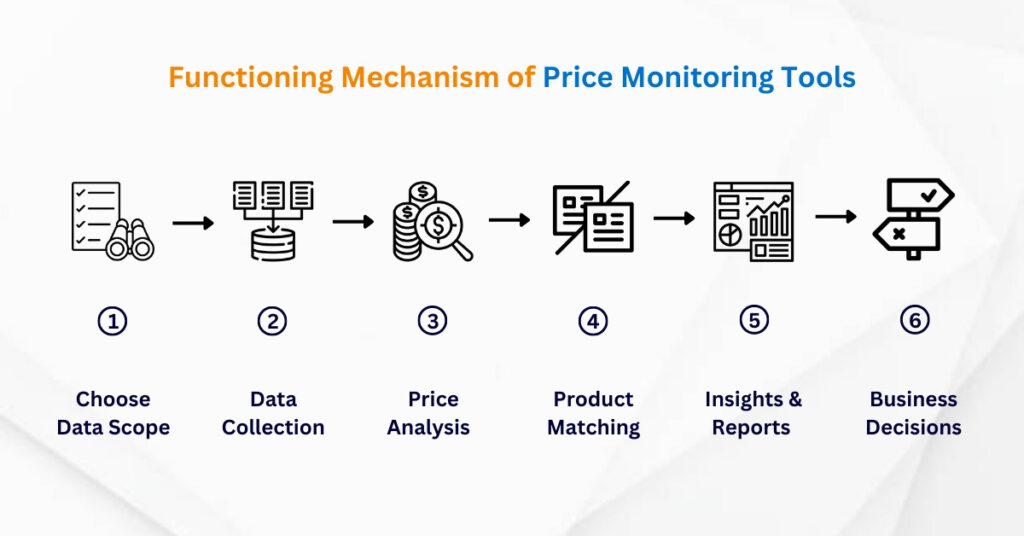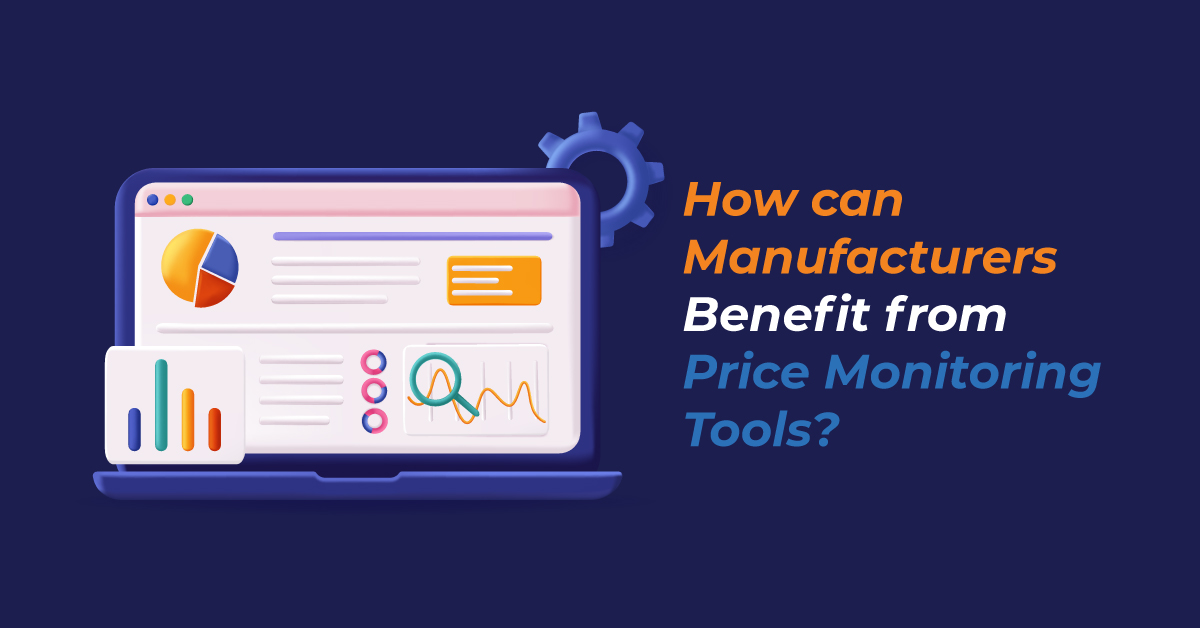A competitive online market can always help companies make better products and offer better services to the customers. Competition is vital for every industry, so only the best practices are followed. Now everybody knows that pricing plays a crucial role in determining the competitive edge for a manufacturer or supplier. And while determining the price of a product, the manufacturer should take into account the cost of a product, quality, profit margin, and brand image. Furthermore, they should also consider the market trends and prices of similar products set by the competitors. To begin with, it is here that price monitoring tools come into the picture.
Knowledge is the key that helps in setting the right price point for your products. Being informed about the pricing trends in the market enables the manufacturer to evolve with the market, keep an eye on the fluctuating trends, and understand the customer better for anticipating the changes and adapting to the same. Competitor price monitoring plays a crucial role for any business.
Today’s blog will help you understand ways in which you can make your products and services better with the help of price monitoring tools.
The task of performing this analysis manually can be rigorous and time-consuming. Thus, automation is the key! Ecommerce price monitoring tools help in saving time and money.
How Do Price Monitoring Tools Work?
The price monitoring tool uses an external partner for automatically retrieving the product data from the website of the competitors followed by comparing the data. The first step is to choose the scope of the data that you wish to monitor. Some competitor price monitoring tools like WebDataGuru offer this service and then perform competitor and market analysis for the business. Our platform is cutting edge and is completely data-driven for your business. You will just have to input data and everything else will be done quickly and efficiently.

You have the choice to opt for analysis of a specific brand/ product range if the catalog has several references. Once the scope of the data is decided, the online price monitoring tools start collecting data. Price can be directly analyzed on the website of the competitor, on the marketplace, or price comparison website. Competitive price analysis tools match the products from the catalog with the competitor prices.
The comparison is done based on AI algorithms which use unique product codes, brands, item specifics, titles, and image recognition.
Essential points to consider while choosing the price monitoring tools:
- Where is the data being sourced from- competitor sites, marketplace, or any other place?
- Is it simple to set up or transfer the information to the tool?
- Are competitor and market analyses included?
- What type of data is being collected? Are you only looking for price information or delivery cost and variable costs as well?
- How the dashboard looks and how detailed it is. Does it allow sharing of analysis and reports easily?
- Is the price monitoring software easily accessible and user-friendly?
- What is the tariff for the platform?
- What automated functionalities are they offering?
How Can Price Monitoring Data be Used?
Once the ecommerce price monitoring toolsextract the data about the competitor, price fluctuation over the time, price differences, and list of common references, you will have a treasure of valuable information about the competitors and the market.
The data offered by online price monitoring tools can help in:
- Keeping up with what is new in the market and the variations based on the seasons.
- Identifying the missing products from your range.
- Setting the right price for launching the new products.
- Manage the stock in an intelligent way and sell it modifying the prices considering the references in the catalog.
- Reduce the prices for being competitive for a specific period of time or throughout the year.
- It helps in knowing when exactly to increase the price of the products that are being sold at a very low price as compared to similar products in the market.
- Capturing the attention of the customers with psychological price rounding.
- Make specific products stand out by putting discounts on the call prices.
- Decrease the prices in markets with fierce competition and increase them in markets where you enjoy a dominant position.
- Exclude a few products from price comparison followed by re-targeting the campaigns.
- Boost the auctions intelligently on Google Ads with custom labels. It is possible to subdivide the product listing depending on the criteria of your choice, develop specific campaigns, and adjust the auctions, which will affect the margin.
All these actions will help in creating more impact if a business can react instantly. Thankfully, the information obtained from competitor price tracking tools can make it possible.
Benefits of Price Monitoring Tools
1. Price reduction to gain a leading position
Consumers always look for the lowest prices as they don’t wish to overpay for a product that is available at cheaper prices with other vendors. They check various websites and make the buying decisions. Thus, the manufacturer should make sure that the products are visible on the price comparison websites/ marketplaces.
It is not possible without market and competitor monitoring. It is important to keep a track of the market changes in the e-commerce sector as they can occur at any time and rapidly.
2. Margin optimization
Though there is tough competition in the e-commerce sector, a business can increase their profit margins without losing its leading position. There are best price monitoring tools that offer crucial reports along with dynamic pricing services which help the sellers in adjusting the prices to the present market situation. Thus, retailers can get accurate pricing and higher profit margins.
3. Tracking historical data
E-commerce arena represents diverse and quick price fluctuations. The prices might change a few times in a single day. Thus, with price monitoring, it is not only essential to monitor the present pricing but also to keep track of historical price changes. It helps in understanding the competitor strategies in a better way along with understanding customer behavior.
4. Benefit from promotions
Sales and discounts are a great way of engaging the customers and increasing profit margins in the online arena. However, it needs proper strategy and preparation. Price tracking tools come in handy and help the sellers in finding out what competitors are doing for promotions. It helps in choosing the right product for campaign and implementing an effective pricing strategy.
There are many pricing monitoring companies offering the latest and up-to-date tools for meeting your specific needs. Some research can help in finding the best tool based on your budget and requirements.
How Price Monitoring Tools Can Be Effective for Manufacturers
1. Competitor Analysis for Competitive Advantage
Price monitoring tools provide manufacturers with real-time data on their competitors’ pricing strategies. According to a study, 71% of businesses found competitor analysis crucial for formulating pricing strategies. By tracking and analyzing competitor prices, manufacturers can identify market trends, adjust their pricing strategy, and gain a competitive edge.
2. Optimal Pricing for Maximized Profitability
Effective pricing is the cornerstone of a successful manufacturing business. Research reveals that companies implementing advanced pricing analytics experienced an average profit increase of 2-7%. Price monitoring tools enable manufacturers to evaluate market demand, analyze pricing elasticity, and identify optimal price points. By aligning prices with customer preferences and market dynamics, manufacturers can maximize profitability.
3. Enhanced Quality Control
Maintaining high product quality is crucial for customer satisfaction and brand reputation. Price tracking tools aid manufacturers in tracking the cost of raw materials and components. A study by Deloitte states that real-time visibility into the cost of raw materials helps reduce costs by 5-15%. By monitoring price fluctuations, manufacturers can identify alternative suppliers or adjust their sourcing strategies, ensuring the use of high-quality materials while optimizing costs.
4. Demand Forecasting and Inventory Management
Accurate demand forecasting and efficient inventory management are essential for manufacturing operations. According to a report, companies leveraging predictive analytics for demand forecasting experienced a 75% increase in forecast accuracy. Competitor price monitoring tools provide manufacturers with valuable insights into market demand trends, enabling them to align production volumes, optimize inventory levels, and minimize excess stock or shortages.
5. Real-Time Market Insights
Price monitoring tools offer manufacturers real-time market insights, enabling them to stay informed about changing customer preferences and market dynamics. A study found that 62% of businesses consider real-time data crucial for successful decision-making. By leveraging up-to-date pricing data, manufacturers can make timely adjustments to their product offerings, capitalize on emerging trends, and remain agile in a competitive marketplace.
6. Increased Profit Margins through Price Optimization
Price monitoring plays a pivotal role in price optimization, allowing manufacturers to strike the right balance between profitability and customer value. One research reveals that effective price optimization initiatives have the potential to increase profit margins by 50-350 basis points. By utilizing price analysis tools to analyze market dynamics, customer behavior, and competitor pricing, manufacturers can optimize prices to maximize both revenue and profit margins.
The Power of Price Monitoring Tools By Your Side
The utilization of price monitoring tools has become an indispensable aspect of modern manufacturing. By embracing these tools, manufacturers can gain a competitive advantage through competitor analysis, optimize prices for profitability, maintain product quality, enhance demand forecasting and inventory management, access real-time market insights, and achieve great success.
So, why are you still reading, Schedule your free demo today!

Recent Comments